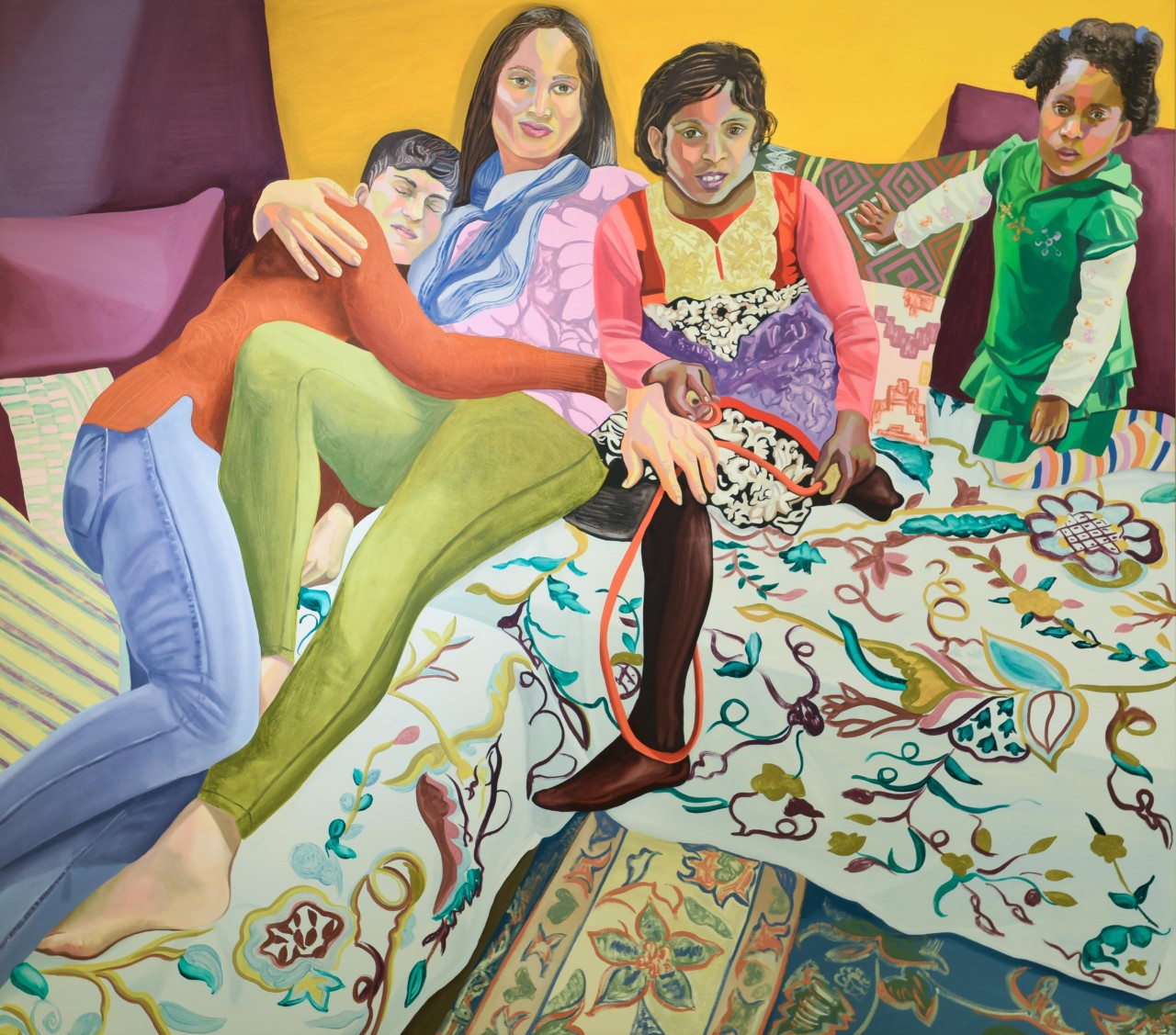


Aliza Nisenbaum, 'Susan, Aarti, Keerthana and Princess, Sunday in Brooklyn', 2018. Image courtesy the artist and Mary Mary, Glasgow
At the centre of this exhibition in Norwich is the painting by Aliza Nisenbaum that the Contemporary Art Society has just donated through the VNXXCAS project, supported by Valeria Napoleone. When the museum’s curator, Harriet Loffler, applied to the scheme, she confronted the gender imbalance within the collections for the first time and calculated that only 7% of the artists with work in the museum were female.
It is a strikingly low figure, and at the lower end of a scale nationally that places Tate at the top with 35% female artists in the collection, and the National Galleries of Scotland at the other end of the scale with 4%. It is important to understand, to contextualise these figures, that the majority of the museum collections around the country were founded in the Victoria era, and consequently reflect the overwhelmingly white, male dominance of the period. Things have changed, however. Things have had to change.
With the arrival of Nisenbaum’s painting in Norwich, very different, 21st century realities enter the collection and enable a multitude of new conversations to take place. There was a palpable sense of excitement that for the first time a work of art depicting women of colour had been acquired, as well as those women being a gay couple, with their children. Susan, Aarti, Keerthana and Princess, Sunday in Brooklyn (2018) presents the family group nestled in a cocoon of colour and pattern. The settled poses of the sitters bespeaks their comfort with each other, and with the painter.
The softness of fabrics and textiles surrounds them with abutting designs that have their origins far away from Brooklyn and New York – from the crewelwork thrown on the couch to the woven cushion and contemporary oriental rug. The emphasis on pattern and colour operates to denote sensuality and a sense of luxury as well as signalling non-western perspectives. Some of these painterly strategies can be seen at work in the orientalist paintings of the late nineteenth century, as well as in Henri Matisse’s paintings of odalisques of the 1920s. Except that here, the reclining female figures gaze candidly out of the picture, fully embodying their own agency as individuals, no more the passive vehicle for metaphor.
At the beginning of the research process that lead to the acquisition of this painting there was a discussion with the museum staff about a key group of works in the collection by Penny Slinger. The artist graduated from Chelsea School of Art in 1969 having developed a visual language she described as feminist surrealism, influenced by her study of European Surrealism, and her friendship with Max Ernst. Two years later, in 1971 she published a book of her collage works entitled 50% - The Visible Woman – from which the exhibition borrows its title. The book is exhibited alongside a slightly later work Head Box, 1971-2, both of which demonstrate Slinger’s concerns with the female psyche and subconscious as constrained within the societal expectations of the time.
On the other side of the gallery Gwen John’s self-contained Girl in a Blue Dress Holding a Piece of Sewing (1914-15) sits immobile in a domestic interior. Her penetrating gaze suggests that, were she not confined by the ladylike imperative to “sew a fine seam” she might be doing something altogether more compelling. In contrast, Marie Laurencin’s tiny, undated watercolour Girl with a Guitar seems a more liberated character, in her beret and accompanied by a bluebird.
Laurencin was an important figure within the Parisian avant-garde of the early 20th century, exhibiting with Picasso, Picabia and Delaunay among others. Her subjects were most frequently women and girls, something that is usefully inflected by the knowledge that she was known to have had affairs with women as well as men.
A trio of photographic self-portraits by the late Jo Spence, from the series Photo-Therapy and Narratives of Disease bring the depiction of women into the later 20th century. In Photo-Therapy Spence portrays herself as her own mother, recovering unrecorded incidents from her life, literally embodying her history. In this, as well as Narratives of Disease, Spence subverts the normal relationship between artist and subject, taking control of her own representation and the narratives that weave about her.
While the number of female artists in the collections at Norwich may be modest, the curator of Visible Women has assembled a broad spectrum of key works that showcases some of the most prominent, as well as more overlooked individuals. At the far end of the gallery are a group of abstract pieces – a large 1980s Bridget Riley, an important painting by Sandra Blow from 1961, a swooping small sculpture by Barbara Hepworth. Also of note is a hauntingly beautiful work by Frances Kearney, depicting her mother in her bathroom, turned away from the camera, smoking, apparently lost in contemplation.
The weather is going to be lovely this weekend – why not head out to Norfolk and take advantage of our wonderful regional museums to enjoy this thoughtful and timely exhibition.
Caroline Douglas
Director
CORRECTION: We stated that 4% of the work in the National Galleries of Scotland’s collection was by female artists, with Tate having 35% female artists in their collection. We’d like to clarify that this figure is for Tate’s Modern and Contemporary holdings, and if you look at the same period in the National Galleries of Scotland’s collection the figure is closer to 18%.
Norwich Castle Museum and Art Gallery, 24 Castle Meadow, Norwich NR1 3JU. Open Monday - Saturday 10.00-16.30, Sunday 13.00-16.30. Exhibition is ongoing. www.museums.norfolk.gov.uk/norwich-castle